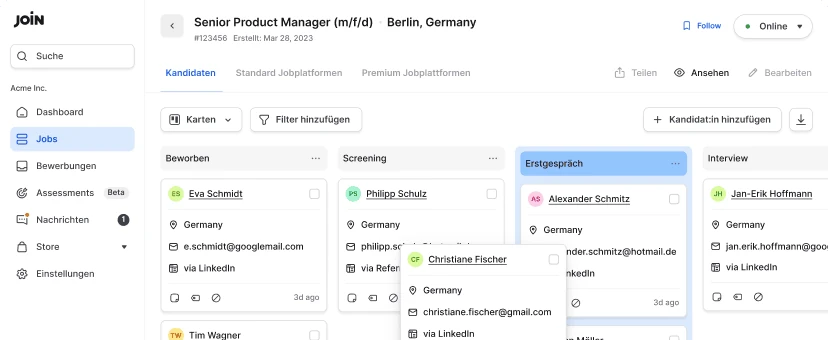10 ways to create a feedback culture in the workplace
Table of contents
Creating an open and continuous feedback culture in the workplace will strongly benefit your business. Learn more about the importance of feedback at work and how to implement a culture of feedback in your workplace.
Table of contents
Your team can’t thrive without a strong feedback culture. Feedback helps employees grow and improves performance, both on an individual and an organizational level. But creating a feedback culture in your workplace isn’t always easy.
Building a company culture where everyone feels comfortable and empowered to both give feedback and receive feedback can be challenging. Especially if you want those feedback loops to result in continuous performance management and evaluation of every individual in your organisation (which you do, and we’ll explain why in a bit).
Making this part of your team’s culture can be difficult. Particularly if you (or your team members) don’t know which feedback models to use. But if you invest in creating a culture of feedback, you will reap the benefits. Your team will excel and grow together.
Below, you will find out why creating an effective feedback culture at work is so important. You will also learn exactly how to build a feedback culture at your workplace by following ten simple steps.
Importance of a feedback culture in the workplace
You’re not perfect, and neither is your colleague. Nor is your boss. We all make mistakes from time to time, and that’s fine. What’s important is that we learn from them, so we can grow and improve. Effective feedback does just that. But that’s not all.
Here are 5 big benefits of building a feedback culture in your business.
1. It saves you money
Let’s start with the most significant benefit. A feedback culture can help you save money. How?
Let’s illustrate this point with some statistics:
- An Officevibe research found that companies that implement regular employee feedback have a 14.9% lower employee turnover rate than companies that don’t.
- A study conducted by Robert Half Talent Solutions found that 66% of employees are likely to leave a job if they don’t feel appreciated, with the number being even higher (76%) for millennials.
- In response to a survey conducted by Globoforce and SHRM, 89% of the surveyed HR leaders said that ongoing peer feedback and check-ins have a positive impact on their organizations.
What this research shows is that employees value feedback in the workplace as it makes them feel more recognized and appreciated, which in turn results in higher employee satisfaction and lower employee turnover.
And that can have a significant impact on your organization’s financial situation. After all, a high employee turnover can be a real financial strain on a business, because it means you have to invest again in attracting and hiring new talent. And current estimates are that each resignation costs a company up to a third of the employee’s annual salary.
Of course, you can save money by using JOIN’s free recruiting software to hire the right talent faster. But ideally, your current employee wouldn’t resign in the first place. A strong feedback culture can help with that.

2. It improves performance
When you give someone feedback, you’re not trying to put them down or simply tell them off. You either want to praise something they’ve done well or explain how they could’ve done something better. Either way, the goal is for them to perform at their best.
In an active feedback culture, employees are continuously asked to reflect on how they do things. This urges them to learn, improve, and grow.
This way, feedback facilitates what is known as a growth mindset, a concept introduced by Carol Dweck, a psychology professor at Stanford University, and further explained in this article. The idea is that people with a growth mindset don’t see mistakes as an embarrassing failure, but rather as an exciting opportunity to learn and develop.
When done right (more on that below), creating a feedback culture in your workplace urges employees not to see feedback as something negative, but as a possibility for growth. This, in turn, will help improve their individual performance and facilitate growth for your business.
3. It promotes open communication
If there’s one thing that’s truly toxic in a working environment, it’s a lack of open, honest communication. Your employees should always feel like they can share their opinions or speak up if they disagree with something.
If this is not the case, you create a company culture filled with secrecy, dishonesty, and pent-up emotions. This drags down morale, performance, and reduces the chance of your company being seen as a great place to work, which in turn negatively impacts talent attraction. A toxic workplace environment can absolutely ruin your business.
By building a culture of feedback, you promote open, honest communication where employees feel heard and are not afraid to speak up. This promotes transparency and facilitates a much more healthy and beneficial way of collaborating within your team.
4. It facilitates better work relationships
This open communication, in turn, leads to much stronger working relationships. By knowing that candour and honest feedback are actively promoted, your colleagues will be more inclined to speak their mind freely. And that isn’t just beneficial for how they do their job.
When done right, a culture like this will make people feel more comfortable and at ease. They will act more like themselves, rather than feeling like they have to put up a facade at work. If everyone feels comfortable enough to be themselves, the working relationships that are formed will be more genuine, more based on trust, and more personal in nature.
For more information about forming better working relationships, check out our article on the importance of team building and company culture.
5. It gives you a wealth of data
Just imagine all the data you will be accumulating when everyone is constantly thinking about improving performance and optimizing how they work (and sharing it openly).
In more traditional companies, feedback tends to be gathered only once or twice a year during the performance reviews. But there is only so much you can discuss during these reviews. Plus, you will have forgotten half of the things that have happened between reviews!
With a continuous feedback culture in place, your team will be able to collect much more data throughout the year, rather than just during a handful of set moments.
How to build a culture of feedback
Now you know more about the importance of feedback in the workplace and having an open feedback culture, it’s time to find out how to actually build such a workplace.
These 10 steps helped us create a strong culture of feedback here at JOIN. We’re convinced it can help your business, too!

1. Start during onboarding
It’s easier to build a new habit from scratch than to change an existing one. And that’s especially true for someone just starting out in your organisation.
When a new team member joins your company, they enter a new working environment filled with different processes, etiquettes, and customs than the workplace they came from. Although they will bring some preferences and ways of working with them, they will always have to adapt and change some parts as well.
The sooner during the onboarding process you teach new employees the specific ways of working within your company, the easier it will be for them to adopt and internalise them.
The same goes for sharing your feedback culture. The sooner you show new team members that your organisation values open and honest feedback, the easier it will be for them to get in the habit of speaking candidly and providing feedback at work.
That’s why we’ve made feedback part of our hiring process. As we share our two-week onboarding program with new employees, we explain that we would like to receive as much feedback as possible directly after the onboarding and that we’ll ask them to fill out a survey.
This teaches colleagues to be open and transparent from day one. We ask them to be as detailed as possible—including providing negative/constructive feedback—as it helps us improve our onboarding process. And this instantly creates a safe space for new employees, knowing that we as a business value their opinion and honest feedback.
We’ll talk more about creating a feedback-safe environment in a bit.
2. Train your team
You can envision a great feedback culture all you want. But if your team members don’t understand the value of feedback or how to effectively give it, it’s never going to work.
That’s why providing feedback training to all members of your team is essential in establishing a strong feedback culture.
You could do this in the form of delivering a company-wide presentation, running workshops within teams, or by simply having everyone read your feedback guidelines or rules.
Whatever format you decide to use, ensure you include the following points:
- Explain why by showing your team the importance of a feedback culture (see section above in this article)
- Explain the different types of feedback and when to use which one
- Explain how to both give feedback and receive feedback (and how to give constructive criticism)
- Set clear expectations around feedback with organizational standards (e.g. never give negative feedback without providing a potential solution for improvement)
3. Create a safe-space
Getting your team members to understand the importance of feedback is one thing. Facilitating an environment where they actually feel comfortable to provide feedback is another.
People are often nervous when it comes to feedback. After all, it tends to highlight how someone did something wrong, and doing something wrong at work can lead to getting fired, right?
That shouldn’t be the way feedback is perceived. Nobody is perfect, and feedback is merely there to help people grow and improve. If someone gives you feedback, it’s not because they think you should be fired. It’s because they want to help you do your job even better than you already are.
To help break through feedback’s stigma, it’s up to the company to create a feedback-safe environment for their employees.
To do so, it’s important to constantly communicate your anti-retaliation policy as a company. Explain how feedback is there to improve people, not to make them lose their jobs, and how there won’t be any repercussions for giving or receiving (constructive) criticism or feedback.
Once your employees realise they can speak freely, your feedback culture will quickly thrive.
4. Start small
Even if your colleagues know they can speak openly, they probably still need some time to get used to it. So start small at first and don’t try to force it too much.
You can’t create a culture overnight. It takes time and effort from your entire team to get in the right mindset and habits to build a strong feedback culture at work.
So consider beginning with little one-on-one praises, before moving on to public shout-outs. And try to give positive feedback a few times first, before providing detailed constructive criticism.
When it comes to creating a feedback culture, you need to remember it’s a process that needs to grow and improve over time.
5. Lead by example
Employees aren’t going to actively give feedback if the management isn’t asking for it nor giving good feedback themselves. And that holds true for businesses of all sizes and structures.
After all, even the flattest of organisational hierarchies have some sort of levels within the ranks. Because at the end of the day, the CEO still decides who gets hired or fired.
So that’s why creating a safe space (as seen in point 3) isn’t enough. The people higher up in the business hierarchy need to actively advocate the feedback culture and practice what they preach.
By leading by example, they show employees that feedback is encouraged, not punished.

6. Make it a routine
This is especially important in the beginning when building your company’s culture of feedback. Feedback needs to become part of your work routine and how you and your team members communicate.
There are many ways of doing this, including the traditional way of scheduling regular feedback meetings, such as monthly employee evaluations (also see point 7). But your culture should go beyond that.
A great example is to finish the week with a team or company-wide meeting where you schedule in a few minutes at the beginning just for shout-outs. Here, open the floor for anyone who would like to give some positive feedback about something a colleague did well that week. This is also a great way to boost the morale and team spirit within your team.
Another example is to use an (automated) weekly feedback form, for example in Slack. The form could ask everyone to give short feedback on how the team performed that week.
Use your creativity and test what works for your team. But try to encourage that feedback becomes part of your team’s routine, rather than a one-off thing.
7. Use the right feedback channel
To build on the previous point, you should use the right feedback channels and ways of delivering feedback (and use them appropriately). Ideally, you use as many ways as possible in your organisation to see what works best for you and your team.
Examples of feedback channels and ways of delivering feedback:
- 1-on-1 sessions
- Town hall meetings
- Team retrospectives
- Anonymous forms
- Automated tools (e.g. feedback apps in Slack)
- Employee surveys (e.g. monthly Net Promoter Score, or NPS, survey)
- 360-degree feedback
- Self-feedback (self-assessment & self-evaluation)
Not all of these formats and channels work for every team, and using all of them at once might result in feedback overkill. Instead, try out different formats as you go and assess what works best by further collecting feedback on your feedback culture.
8. Create the right balance
Although we suggested earlier on to start with positive feedback, you need to ensure that this isn’t the only feedback that’s being given.
Many employees will at first resort to just giving shout-outs and praise. That’s fine. But you should monitor the situation to ensure that your feedback culture grows into more than that. After all, although positive feedback is great for team morale, you do need constructive feedback as well to help your team grow.
That’s why you should nurture both positive and corrective feedback equally to eventually create the right balance of praise and improvement.
9. Ensure feedback leads to action
Another common trap that teams fall into is that they don’t follow through with the feedback that’s given. This can happen for several reasons.
In some cases, the receiver might not fully understand how they can improve their actions. For whatever reason, they don’t ask for further clarification and instead simply thank the giver for the feedback and leave it at that.
Or perhaps the receiver doesn’t agree with the feedback but doesn’t want to risk getting into an argument. Instead, they say they’ll take the feedback on board without any intention of actually changing their ways.
When handled like this, feedback is useless and can even lead to resentment among team members. Instead, whenever feedback is given, the two parties should conclude on next steps and follow up on these.
Effective feedback should always lead to action or a decision.
10. Add feedback to your company culture’s DNA
Lastly, your company and everyone in it needs to truly embrace your feedback culture and live by it. Make feedback a constant, integral part of your company culture if you really want to reap the benefits.
Here at JOIN, we’ve even embedded our continuous feedback culture into our company values. A powerful feedback culture is ingrained in your company’s DNA.
Creating a feedback culture
Remember that creating a feedback culture requires more than just quarterly performance reviews and the odd employee survey. You need to make it a part of everything you do and try out different ways of giving and receiving feedback that work for you.
Building a strong feedback culture isn’t easy. And we can ensure you it will take time, effort, and a lot of mistakes. But with the right tools and a real growth mindset, you too can create a culture of feedback that thrives.
Need more inspiration on how to grow and work efficiently within your business with the help of feedback? Then check out our article on giving candidate feedback after rejection.
Frans Lelivelt
Frans is JOIN's multilingual Senior Content Manager. His main topic of interest in the recruitment space is DEI and how companies can reduce their (unconscious) biases to make the world of work a fairer, kinder place for everyone. Outside of work, he tries to do the same for animals, spending much of his spare time in the kitchen preparing plant-based feasts.


